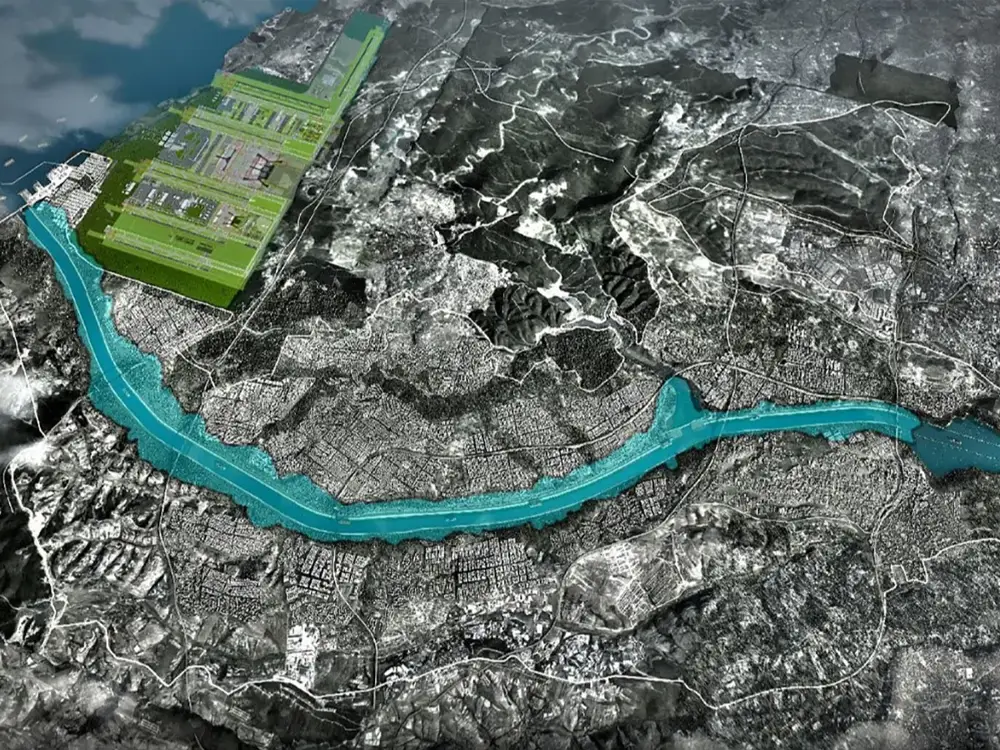The New Istanbul Canal represents an exceptional turning point in the sector of transport and trade in Turkey. This project, which was initiated in 2017, means that a new water route will connect the Black Sea with the Sea of Marmara, relieving pressure on the Bosphorus Strait Canal, and attracting the largest ships and tankers through Turkey to various other countries.
Which made the Turks describe the Istanbul Canal as “the project of the era,” hoping for unlimited prosperity and growth.

What is the Istanbul Canal project?
The design of the Istanbul Water Canal is an artificial path with a length of 45-50 kilometers, a depth of 25 meters, and a width of 150 meters, allowing the passage of the largest ships, tankers, and submarines, with several up to160 vehicles, with a commercial load weighing up to 150 million tons.
The channel being built extends between the Black Sea to the north and the Sea of Marmara to the south, parallel to the Bosphorus Strait to the west. It has long been one of the most famous waterways separating East and West, and the most vibrant and crowded in navigational traffic.
The Turkish government inaugurated the canal in 2021, but it will not operate until 2027, which is the date of the canal Istanbul completion, with a total cost of $25 billion. Costs that the state hopes to compensate quickly with annual revenues exceeding 8 billion dollars, according to official projections.
Map of the new Istanbul Canal
The canal Istanbul map shows the start of its path from the line dividing the Sea of Marmara and Lake Küçükçekmece, passing through the Sazlıdere Dam through the Altinşehir and Sahintepe regions, reaching the Black Sea from the east of Lake Terkos, which means Crossing through areas belonging to four municipalities: “Arnavutköy”, “Kucukcekmece”, “Başakşehir” and “Avcılar”.
Six bridges are also distributed on the map, linking the east and west of the Istanbul Canal, with the possibility of building additional bridges.
The map also includes building 3 artificial islands from the leftovers of the canal and constructing an opera house on one of them.

The new Istanbul Channel site
The Istanbul Canal project cuts through the city's economic heart par excellence, specifically on the European side, where commercial activity is enormous. The location of the city spreading over two continents gives the new waterway promising momentum.
In addition to the four aforementioned municipalities, the Turkish government intends to establish a new city bearing the name “Yenisehir” in the lands surrounding the project, to be an attraction center for Turkish and foreign investors and residents alike, similar to many “Smart” cities are being developed in several countries.
The canal's location is also distinguished by its proximity to Istanbul Airport, which is an extra privilege.
The importance of the new Istanbul Canal
The new Istanbul Canal project has enormous advantages, most notably the huge revenues that will supply the Turkish state treasury.
These benefits can be viewed on three main levels of importance, shaping the new face of Turkey:
The economic importance of the Istanbul Canal:
- Enhancing maritime navigation in Turkey, and providing it with an additional financial resource in the form of fees that the state will charge for traffic in the new strait.
- Eliminating slums, and investing in uninhabited lands located on both sides of Istanbul Canal, means building infrastructure suitable for attracting the activity of new housing, offices, and companies that are now trying to reserve a place for themselves along the promising route, which means a profitable work environment, projects and employment opportunities that contribute to increasing Individual and national revenue.
- This compensates the Turkish government for the relatively low prices it charges for ships crossing the Bosphorus Strait, as the government expects to collect about $5 for every ton of goods and shiploads passing daily.
- Reducing the pollution resulting from maritime transport in the Bosphorus Strait alone.
- Increasing the region’s appeal to investors and economists in general, looking for markets that promise long-term growth, driven by the state’s support for this project.

The real estate importance of the Istanbul Canal:
The current pace of construction on the canal in Istanbul was reflected in the prices of the lands adjacent to it. The price of a square meter of land in the village of Çamlar, for example, rose from 6 to 184 dollars, and in other locations, the price of a square meter reached 800 dollars after it was only 25 dollars, and this contributed to:
- Activating the purchase and selling of real estate, as local and foreign real estate companies rushed to buy lands adjacent to the canal, relying on their awesome future returns.
- Converting the legal designation of many lands from agricultural to suitable for reconstruction opens the door wide for future urban growth.
- Most of the lands have the probability of reorganization, which means the possibility of investing in them.
The tourist importance of Canal Istanbul:
There is no doubt about the famous position of Istanbul on the global tourism map, and the beautiful facilities on both sides of the Bosphorus Strait attest to this and give a glimpse of what the new canal can add in this regard.
In addition to the opera house included in the plan of one of the prospective artificial islands, dozens of real estate and tourism companies are preparing to establish resorts and entertainment facilities along the route of the Istanbul Canal, with views that are expected to be breathtaking, which will give the naturally excellent Turkish tourism additional push, and increase the attractions, which will provide the country with more income.
The Istanbul Canal and the Montreux convention
In January 2018, the Turkish Prime Minister and a former Transport Minister, Binali Yıldırım, announced that the Canal would not be subject to the terms of the Montreux Convention, this means greater Turkish autonomy concerning the passage of military ships, which are limited in number, tonnage, and weaponry, from the Black Sea to the Sea of Marmara.






